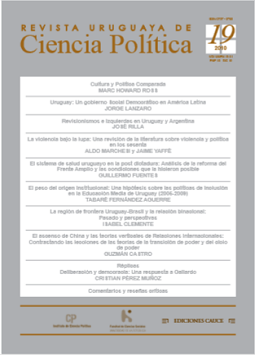China’s Rise and the Vertical Theories of International Relations
Contrasting the Lessons from Power Transition and Power Cycle Theories
Keywords:
China’s rise; international relations theory; power transition theory; power cycle theory; hegemonic warAbstract
The "rise of China" has established itself as a central issue in hig international politics in the 21st century. Acknowledging the analytical challenge that such a phenomenon presents, different theoretical schools have ignited a debate concerning its consequences over the international system. This article introduces and further develops the debate between two models that, although less commented than the traditional schools in realism and liberalism, are particularly useful to analyze massive vertical movements in the international system, such as China’s rise. These are: power transition and power cycle theories. After studying their main theoretical and normative underpinnings, the author demonstrates that power cycle theory is a stronger and more useful framework in the essential task of, not only understanding such a phenomenon but also developing sound policy strategies to peacefully manage the rise of China.
Downloads
References
Bergsten, C. Fred, Charles Freeman, Nicholas R. Lardy y Derek Mitchell (2008). China’s Rise: Challenges and Opportunities. Washington D.C.: Peterson Institute for International Economics and the Center for Strategic and International Studies.
Brown, Michael et al. (2000). The Rise of China. Cambridge, Massachusetts: MIT Press.
Caryl, Christian (2010). "Panda-Hugger Hungover," Foreign Policy, August. Disponible online: http://www.foreignpolicy.com/articles/2010/08/04/panda_hugger_hangover
Cashman, Greg (2000). What Causes War? An Introduction to Theories of International Conflict. Lanham: Lexington Books.
Castro, Guzmán (2010). "Essays on Modern China: The Uses of History as a Political Device", Universidad ORT, Documento de Investigación Nº 55, Montevideo, Uruguay.
Castro, Guzmán (2010b). "Triangular Dynamics: U.S.-China Relations and Taiwan," Centro Argentino de Estudios Internacionales (CAEI). Marzo. Working Paper Number 51. Disponible online: http://caei.com.ar/es/programas/asia/51.pdf
Chambers, Sam (2010). "China’s Ticking Time Bomb," The New York Times. 16 August. Disponible online: http://www.nytimes.com/2010/08/17/opinion/17iht-edchambers.html
Chiu, Daniel Y. (2003). "International Alliances in the Power Cycle Theory of State Behavior," International Political Science Review, Volume 24. Number 1, pp. 123-136.
Christensen, Thomas (2005). "Taiwan’s Legislative Yuan Elections and Cross-strait Relations", China Leadership Monitor, Winter. Volume 13.
Cooper, Helene, Michael Wines y David Sanger (2009). "China’s Role as Lender Alters Dynamics for Obama’s Visit," The New York Times, November 14. Disponible online: http://www.nytimes.com/2009/11/15/world/asia/15china.html
De Soysa, Indra, John R. Oneal y Yong-Hee Park (1997). "Testing Power-Transition Theory Using Alternative Measures of National Capabilities," The Journal of Conflict Resolution, August. Volume 41. Number 4, pp. 509-528.
Doran, Charles F. (1983). "War and Power Dynamics: Economic Underpinnings," International Studies Quarterly, December, Volume 27, Number 4, pp. 418-441.
Doran, Charles F. (1991). Systems in Crisis: New Imperatives of High Politics at Century’s End. Cambridge: Cambridge University Press.
Doran, Charles F. (2003). "Economics, Philosophy of History, and the ‘Single Dynamic’ of Power Cycle: Expectations, Competition, and Statecraft," International Political Science Review, Volume 24, Number 1, pp.13-49.
Fewsmith, Joseph (2001). China Since Tiananmen: The Politics of Transition. Cambridge: Cambridge University Press.
Friedberg, Aaron (1988). The Weary Titan: Britain and the Experience of Relative Decline, 1895-1905. Princeton, New Jersey: Princeton University Press.
Friedberg, Aaron (2005). "The Future of U.S.-China Relations: Is Conflict Inevitable?" International Security, Fall, Volume 30, Number 2, pp. 7–45.
Gilpin, Robert (1981). War and Change in World Politics. Cambridge: Cambridge University Press.
Goldstein, Avery (2007). "Power Transitions, Institutions, and China’s Rise in East Asia: Theoretical Expectations and Evidence," The Journal of Strategic Studies, August-October. Volume 30, Number 4-5, pp. 639-682.
Ikenberry, John (2008). "The Rise of China and the Future of the West," Foreign Affairs, January-February.
Johnston, Alastair Iain (1996). "Learning versus adaptation: Explaining Change in Chinese Arms Control Policy in the 1980s and 1990s," China Journal, January, Volume 35, pp. 27-62.
Kennedy, Paul (1989). The Rise and Fall of The Great Powers. New York: Vintage Books.
Kohout, Franz (2003). "Cyclical, Hegemonic, and Pluralistic Theories of International Relations: Some Comparative Reflections on War Causation," International Political Science Review, Volume 24, Number 5, pp. 51–66.
Kugler, Jacek y Douglas Lemke (1996). Parity and War: Evaluations and Extensions of the War Ledger. Michigan: University of Michigan Press.
Lahneman, William J. (2003). "Changing Power Cycles and Foreign Policy Role–Power Realignments: Asia, Europe, and North America," International Political Science Review, Volume 24, Number 1, pp. 97–111.
Lampton, David M. (2001). Same Bed Different Dreams: Managing U.S.-China Relations 1989-2000. Berkeley: University of California Press.
Lampton, David M. (2009). "The United States and China in the Age of Obama: Looking at Each Other Straight in the Eyes," Draft.
Lemke, Douglas (1997). "The Continuation of History: Power Transition Theory and the End of The Cold War." Journal of Peace Research, February, Volume 34, Number 1, pp. 23-26.
Lemke, Douglas y Suzzane Werner (1996). "Power Parity, Commitment to Change, and War," International Studies Quarterly, Volume 40, Number 2, pp. 236-260.
Lemke, Douglas y Ronald Tammen (2003). "Power Transition Theory and the Rise of China," International Interactions, Volume 29, Number 4.
Organski, A.F.K. y Jacek Kugler (1980). The War Ledger. Chicago: University of Chicago Press.
Rose, Charlie (TV). Disponible online: http://www.charlierose.com/download/transcript/10681.
Shambaugh, David (1996). "Containment or Engagement of China? Calculating Beijing Responses," International Security, Fall, Volume 21, Number 2, pp. 180-209.
Shambaugh, David (2008). China’s Communist Party: Atrophy and Adaptation. Washington: Woodrow Wilson Center Press/University of California Press.
Tammen, Ronald, et al. (2000). Power Transitions: Strategies for the 21st Century. New York: Chatham House.
Tessman, Brock (2009). "The Evolution of Chinese Foreign Policy: New Incentives with Slowing Growth," Asian Security, Volume 5, Number 3, pp. 396-318.
Waltz, Kenneth (2000). "Structural Realism After the Cold War," International Security, Volume 25, Number 1, pp. 5-41.
Waltz, Kenneth N. (2001). Man, the State and War. New York: Columbia University Press.
Wright, Thomas (2010). "How China Gambit Backfired," The Diplomat, 28 de Julio. Disponible online: http://the-diplomat.com/2010/07/28/how-china-gambit-backfired/
Yoon, Young-Kwan (2003). "Introduction: Power Cycle Theory and the Practice of International Relations," International Political Science Review, Volume 24, Number 1, pp. 5-12.



























